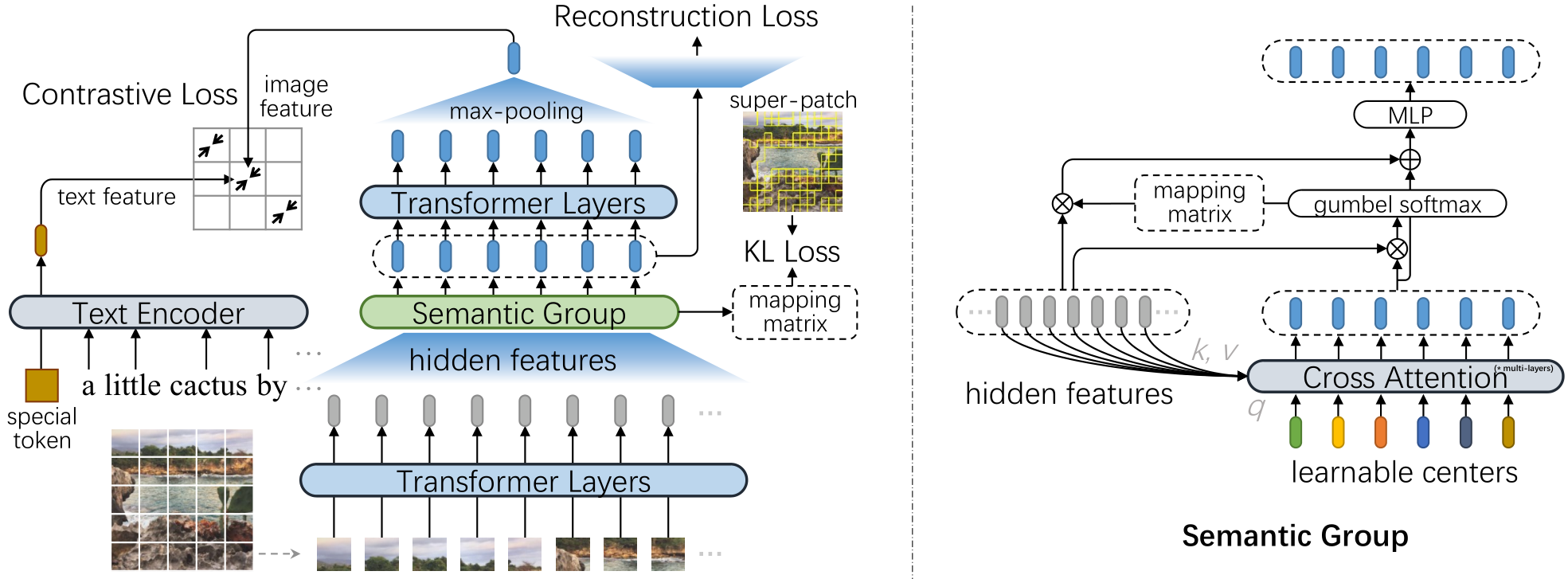The implementation of paper SegCLIP: Patch Aggregation with Learnable Centers for Open-Vocabulary Semantic Segmentation.
In this paper, we propose a CLIP-based model named SegCLIP for the topic of open-vocabulary segmentation in an annotation-free manner. The SegCLIP achieves segmentation based on ViT and the main idea is to gather patches with learnable centers to semantic regions through training on text-image pairs. The gathering operation can dynamically capture the semantic groups, which can be used to generate the final segmentation results. We further propose a reconstruction loss on masked patches and a superpixel-based KL loss with pseudo-labels to enhance the visual representation. Experimental results show that our model achieves comparable or superior segmentation accuracy on the PASCAL VOC 2012 (+0.3% mIoU), PASCAL Context (+2.3% mIoU), and COCO (+2.2% mIoU) compared with baselines.
conda create -n segclip python=3.8 -y
conda activate segclip
conda install pytorch==1.8.0 torchvision==0.9.0 cudatoolkit=11.1 -c pytorch -c conda-forge
pip install mmcv-full==1.3.14 -f https://download.openmmlab.com/mmcv/dist/cu111/torch1.8.0/index.html
pip install mmsegmentation==0.18.0
pip install webdataset==0.1.103
pip install timm==0.4.12
pip install opencv-python==4.4.0.46 termcolor==1.1.0 diffdist einops omegaconf
pip install nltk ftfy regex tqdm
pip install prefetch_generator
pip install Pillow==8.2.0mkdir checkpoints
wget -P ./checkpoints https://github.com/ArrowLuo/SegCLIP/releases/download/checkpoint_v0/segclip.binNote: vis_mae_decoder.* is not used in inference, so ignore the part of the log.
# voc
python main_seg_vis.py --input demo/examples/voc.jpg --device cuda:0 --vis input input_pred_label \
--dataset voc --init_model checkpoints/segclip.bin
# context
python main_seg_vis.py --input demo/examples/context.jpg --device cuda:0 --vis input input_pred_label \
--dataset context --init_model checkpoints/segclip.bin
# coco
python main_seg_vis.py --input demo/examples/coco.jpg --device cuda:0 --vis input input_pred_label \
--dataset coco --init_model checkpoints/segclip.binThe results can be found in output/vis_imgs/input_pred_label in default.
Download the Pascal VOC dataset, Pascal Context dataset, and COCO dataset. For the COCO conversion, using convert_dataset/convert_coco_object.py or preprocess/convert_coco_object4val.py instead of tools/convert_datasets/coco_stuff164k.py.
To run the below script, the data_root in seg_segmentation/configs/_base_/datasets/*.py should be modified at first.
# voc
CUDA_VISIBLE_DEVICES=0,1,2,3 python -m torch.distributed.launch --nproc_per_node=4 \
main_seg_zeroshot.py --dataset voc --init_model checkpoints/segclip.bin
# context
CUDA_VISIBLE_DEVICES=0,1,2,3 python -m torch.distributed.launch --nproc_per_node=4 \
main_seg_zeroshot.py --dataset context --init_model checkpoints/segclip.bin
# coco
CUDA_VISIBLE_DEVICES=0,1,2,3 python -m torch.distributed.launch --nproc_per_node=4 \
main_seg_zeroshot.py --dataset coco --init_model checkpoints/segclip.bin The data config can be found in dataloaders/data_config.py
Note: before running the scripts of data preprocess, the corresponding data path should be modified.
Download 2014 train images and karpathy split
mkdir -p data/mscoco
wget https://images.cocodataset.org/zips/train2014.zip -P data/mscoco
unzip data/mscoco/train2014.zip -d data/mscoco/ && rm data/mscoco/train2014.zip
python preprocess/COCO/write_coco_images.py --input_root data/mscoco --output_root data/COCO --data_split train2014
# Generate coco_train2014_seg_scale224_sigma9.0_min_size224.lmdb
python preprocess/COCO/felzenszwalb_extraction_coco.py
Download the image text pairs of GCC3M via img2dataset. More details are referred to img2dataset CC3M tutorial.
wget https://storage.cloud.google.com/gcc-data/Train/GCC-training.tsv?_ga=2.191230122.-1896153081.1529438250
cp Train_GCC-training.tsv cc3m_train.tsv
sed -i '1s/^/caption\turl\n/' cc3m_train.tsv
img2dataset --url_list cc3m_train.tsv --input_format "tsv" \
--url_col "url" --caption_col "caption" --output_format webdataset \
--output_folder cc3m_train --processes_count 16 --thread_count 64 --image_size 224 \
--resize_mode keep_ratio --resize_only_if_bigger \
--enable_wandb False
# Note: Step 1.1 ~ 1.3 can be merged together, which can generate lmdb directly along with extracting images from tar files without generating the middle pickles.
# Step 1.1: Generate cc3m_train_desc.pkl
python preprocess/GCC3M/extraxt_images_from_tar.py
# Step 1.2
python preprocess/GCC3M/combine_pickle.py
# Step 1.3: Generate cc3m_train_lmdb_total and cc3m_train_lmdb_total_keys.pkl
python preprocess/GCC3M/generate_lmdb_from_pickles.py
# Step 2: Generate cc3m_train_lmdb_total_seg_scale224_sigma9.0_min_size224.lmdb
python preprocess/GCC3M/felzenszwalb_extraction_cc.pyDownload the CLIP weight,
wget -P ./modules https://openaipublic.azureedge.net/clip/models/5806e77cd80f8b59890b7e101eabd078d9fb84e6937f9e85e4ecb61988df416f/ViT-B-16.ptthen run the pretraining script,
CUDA_VISIBLE_DEVICES=0,1,2,3,4,5,6,7 python -m torch.distributed.launch --nproc_per_node=8 main_task_align.py \
--do_pretrain --num_thread_reader=10 --epochs=10 --batch_size=768 --n_display=50 \
--output_dir ckpts/ckpt_segclip --lr 4e-3 --max_words 32 \
--datatype cc,coco, --lower_lr 4e-6 --use_pin_memory --use_seglabel --use_vision_mae_reconIf you think this code is helpful or instructive in your research, please cite:
@Article{Luo2023SegCLIP,
author = {Huaishao Luo and Junwei Bao and Youzheng Wu and Xiaodong He and Tianrui Li},
title = {{SegCLIP}: Patch Aggregation with Learnable Centers for Open-Vocabulary Semantic Segmentation},
journal = {ICML},
year = {2023},
}Our code is based on GroupViT, CLIP, and CLIP4Clip. Thanks for their contributions to the community.
